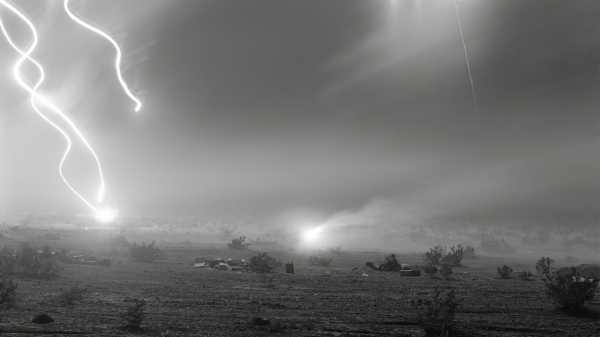
Save this storySave this storySave this storySave this story
The photographer An-My Lê was born in Saigon in 1960, six years into the Vietnam War. Four days before North Vietnamese forces captured the city, in 1975, Lê and her family caught an American airlift out of Vietnam; after shuttling through military bases in the Philippines, Wake Island, Guam, and California, they settled in Sacramento. Nightly shelling and food shortages had been commonplace during her childhood. Yet “growing up in Vietnam during the war was actually not that dramatic for me,” Lê recalled in a 2018 interview. “War was part of our life . . . I don’t think I ever realized how frightening the war was until I was actually in the United States, looking at the news.”
For three decades, Lê has interrogated the representation of war not by documenting conflict as it occurs in the present but through its preënactments and reënactments: staged battles, training exercises, film sets, and the myriad ways in which conflict is performed, rehearsed, or mythologized. On view at MOMA in her first New York survey, “An-My Lê: Between Two Rivers/Giữa hai giòng sông/Entre deux rivières,” her work charts how conflict embeds itself in both physical and psychological terrains.
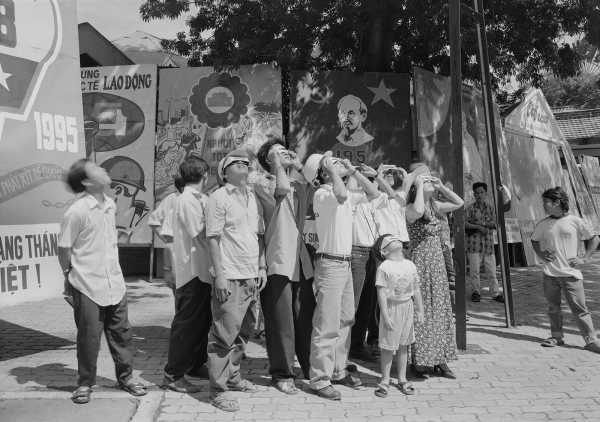
“Untitled,” Ho Chi Minh City, 1995.
Lê’s approach materialized on a trip to Vietnam in 1994, the same year that the Clinton Administration lifted a trade embargo that had been in place since the end of the war. Revisiting the country for the first time in nineteen years, Lê felt that she “didn’t recognize anything in Vietnam,” she explained in an interview with the writer Viet Thanh Nguyen. “It didn’t make sense to me at all. Whatever it is I was looking for, it was in the landscape.”
She had come to her medium by chance: as a biology student at Stanford, Lê audited courses with the photographer Laura Volkerding, got hooked, and upon graduation moved to France as a staff photographer for a craftsman’s guild. There, she adopted the large-format cameras favored by nineteenth-century photographers like Eugène Atget. The images from her 1994 trip, which would come together as her “Viêt Nam” series, reflect Atget’s attention to the symbolic significance of architecture and domestic interiors, as well as Lê’s own awareness of how history superimposes itself onto the physical landscape. In a theme that recurs throughout her work, the photographs also demonstrate how even leisure can shade into violence in the wake of war. One depicts kites dotting the sky that, when blurred by movement, conjure a squadron of fighter jets.
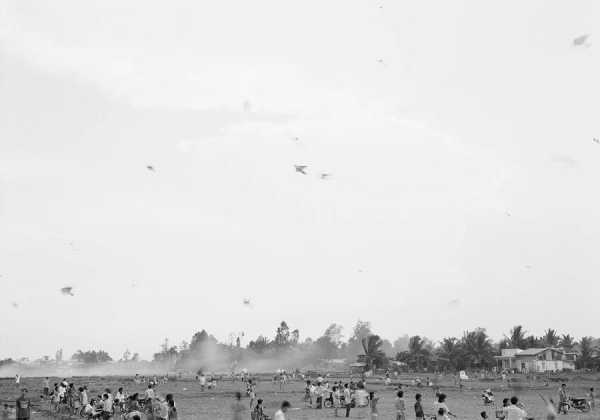
“Untitled,” Ho Chi Minh City, 1998.

“Mechanized Assault,” 2003-2004.
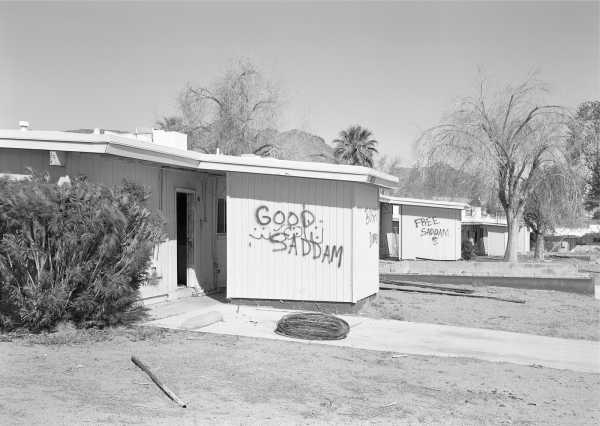
“Security and Stabilization Operations, Graffiti I,” 2003-2004.
In the late nineties, Lê contacted a group of Vietnam War reënactors in Virginia, who invited her to observe them on the condition that she participate. In the resulting series, “Small Wars,” Lê can be seen lying in ambush wearing the black pajamas of the Vietcong, or conferring with a G.I. as a collaborator. The pictures contain both natural beauty and a dramatic sense of disquiet: one image, “Rescue,” shows commandos spilling out of a dead-stock warplane into a serene pine forest suffused with smoke. By positioning the performance of a distant conflict against a familiar backdrop, Lê generates an uncanny atmosphere, infused with her own history of displacement. The pictures also recall how the Vietnamese jungle was itself treated as an enemy combatant during the war, and the various herbicides—Agent Orange the most infamous among them—used to cull a seemingly hostile environment.
After the U.S. invaded Iraq, in 2003, Lê applied to travel there as a war correspondent. Given the long delay to receive credentials, she went, instead, to the Mojave Desert for her next project, “29 Palms” (2003-2004), named after the world’s largest Marine training facility. Here, Lê documented the elaborate fictions inherent in war, as her subjects conducted their exercises amid fake villages complete with “graffiti” proclaiming “GOOD SADDAM” and “GO AWAY!” The series instills a sense of what Lê refers to as the military sublime—its capacity for “shock and awe”—through photographs like “Night Operations IV,” which captures rocket fire arcing between ground and sky like lightning bolts. But Lê also repeatedly undercuts this impression of magnitude by juxtaposing the exercises with the natural landscape; in “Mechanized Assault,” tanks scurry across an imposing desert, engulfed by the domineering mountain range in the background.
Any effort to document the scale of the United States’ sprawling military apparatus must contend with the difficulty of visualizing what the historian Daniel Immerwahr has described as America’s “pointillist empire”; namely, its vast holdings of annexed territories across the Pacific and Caribbean, along with the roughly eight hundred bases that it maintains abroad. Between 2005 and 2014, Lê accompanied the U.S. Navy as it conducted peacetime activities across all seven continents, for the series that would become “Events Ashore.” The first of her projects to use color, the photographs convey the extent of these operations through the stillness of a celadon sea, the white glare of the Arctic, the rich foliage of Indonesian and Ghanaian forests. Perspective is used to significant effect; “Manning the Rail, U.S.S. Tortuga, Java Sea” (2010) presents half a dozen figures arranged along the prow of a battleship, as a fleet of vessels spills out before them like so many rubber duckies. Even as Lê’s photographs often reduce hulking aircraft carriers and amphibious vehicles to toylike size, her closeup portraits of rank-and-file soldiers and technicians evince an expansive empathy for her human subjects. As sailors set up a shooting range aboard the U.S.S. Peleliu, their bodies map onto the contours of their targets’ silhouettes just a little too precisely.

“Small Arms Target Practice,” U.S.S. Peleliu, Pacific Ocean, 2006.
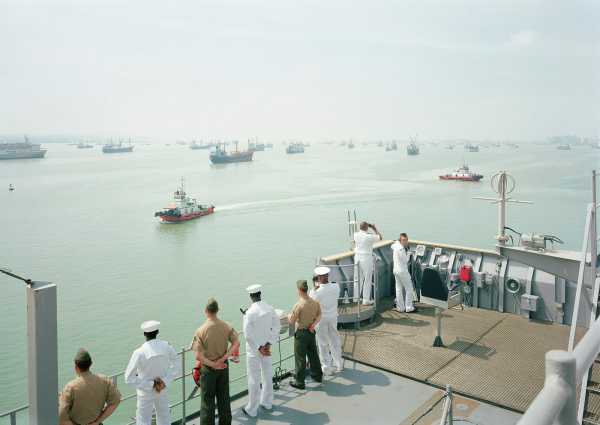
“Manning the Rail,” U.S.S. Tortuga, Java Sea, 2010.
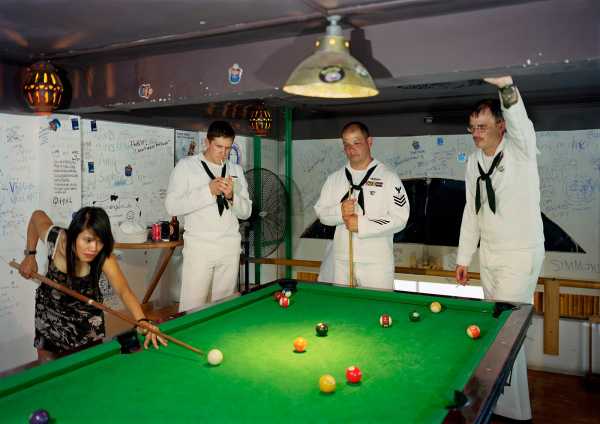
“Sailors on Liberty from U.S.S. Preble,” Bamboo 2 Bar, Da Nang, Vietnam, 2011.
For the ongoing project “Silent General,” Lê turned her lens to the mainland, travelling from the sites of Confederate monuments and border crossings along the Gulf Coast and Rio Grande to the halls of power in Washington, D.C., and student protests in New York City. Taking its title from a passage in Walt Whitman’s “Specimen Days & Collect,” the poet’s fragmentary recollection of the Civil War, “Silent General” examines the nation’s contested legacies. In 2015, the director of the film “Free State of Jones,” about a faction of Confederate deserters and formerly enslaved people in a Mississippi county, invited Lê to photograph the set. In the resulting images, she uses the mechanics of film production to puncture the spectacle of war. During one battle scene, her camera focusses not on the explosion of mortars or soldiers filling a trench but on the workers holding a boom microphone and light reflector in the foreground. (The film’s star, Matthew McConaughey, is blurred beyond recognition.)
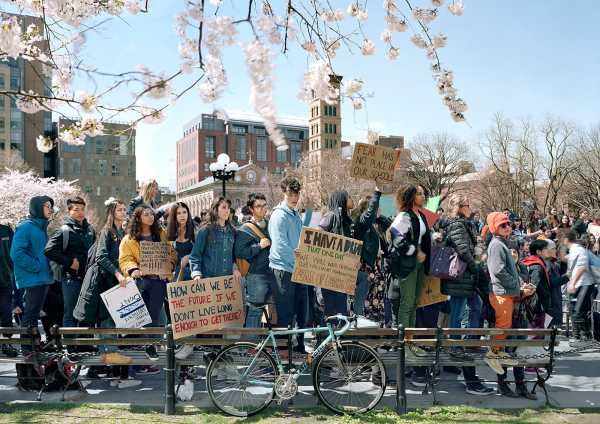
“High School Students Protesting Gun Violence,” Washington Square Park, New York City, 2018.
“History doesn’t move through time in a straight line,” Lê explains in her exhibition’s catalogue. In one of the galleries at MOMA, Lê has installed fourteen ten-foot-high panels into a panorama that she calls “Fourteen Views” (2023). Composed of pictures she took in France, Louisiana, and Vietnam, the installation threads together their colonial heritage while also refusing any narrative of continuity. An archway in Đông Hà leads into a burning sugarcane field in Houma, Louisiana; the manicured gardens of a French estate into a waterfall along the Vietnam-China border.
Lê describes the installation as a response to the cyclorama, which became a popular form of entertainment in the nineteenth century. Viewers would enter a chamber containing a three-hundred-and-sixty-degree view of an enormous painting, usually one that glorified military conquests by rendering them into one unbroken landscape. In its immersiveness, the cyclorama anticipates the contemporary panoply of war, in which images have become more immediately accessible and easily disseminated; each an individual record of horror, but blending, as a whole, into a numb, ambient sameness. Lê’s process—deliberately cumbersome, laborious, and immensely patient—stands in sharp contrast. Her photographs function as an act of repair, uncovering subterranean histories in order to witness them anew.
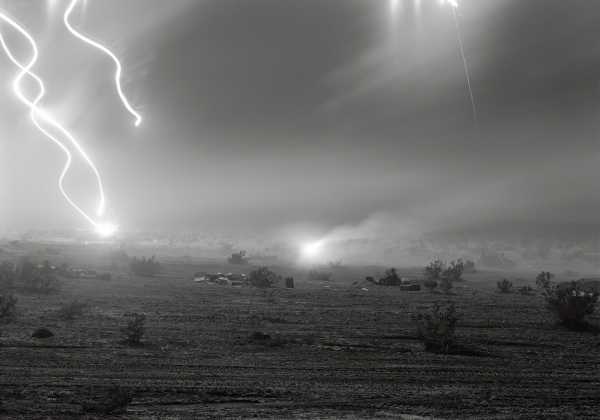
“Night Operations IV,” 2003-2004.
Sourse: newyorker.com